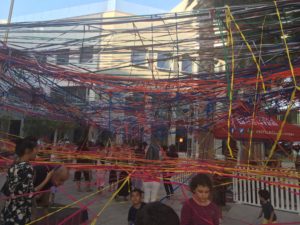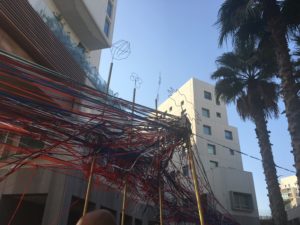It was almost four o’clock in the afternoon and I was walking towards the palm trees in front of the Campus Center to participate in Tangle. In the distance, I could already hear some tunes playing and many children laughing. I only had a very basic idea of what was waiting for me when I reached the space. We had seen a video in class a week before about the show we were supposed to take part in. It showed many kids running around and tangling colorful string. As I watched the video, I smiled. They seemed to be having lots of fun. At that moment, I started to look forward to the day of the event.
I reached the exhibit. It was an area right next to the palm trees was surrounded by a white fence. Inside it, there were stages with tall poles where some colorful strings already could be seen tangled at the very top. I could also see a group of men and women were dressed up in a funny-looking outfit. And around thirty children accompanied by their parents were bursting with excitement ready to enter the space. Suddenly, a soundtrack music started playing and the performers began their act as the audience waited outside. They playfully ran around the space, interacted with each other, and at one point, they pretended wind was blowing them away. Once they were finished, they opened the gates for people of all ages to enter the space. One by one, as participants walked through the gate, they were handed one colorful ball of elastic string. And even without any type of verbal instruction, everyone was left to their own imagination and creativity.


Tangle was an interactive experience where participants were able to their own experience and that of others by creating a space together by tying elastic strings around poles, fences, and each other. I was able to observe four types of participants in the experience: children, parents, Polyglot performers, and observers. Each one of them had a particular role that influenced the performance in some way.
The children were at the center of the performance. It was them that brought to life the space, the imagination, and the creativity. There were children running around tangling around poles and other strings, and others using the strings as objects for play (i.e. using them as hammocks or swings). The parents could be seen interacting with the children happily without interfering too much in their play. They were clearly letting the young ones appropriate the space and make it their own. It was very beautiful to see such an intimate interaction where the parents were letting their children take the lead. The performers were simply pushing for more interaction between participants. Their main job was tangling people with each other, showing different ways of tangling the string, and talking playfully to children. The observers, on the other hand, were standing closer to the fence than to the poles or the strings. They were outsiders, hesitant to join in the experience as easily as the other three. And I was one of them. In some way I felt out of place in terms of age and activity. I wasn’t a child, I wasn’t a parent with her child, and I wasn’t a performer. I was just there to appreciate others’ beautiful interactions.
Every participant with his or her unique role contributed to the experience. It was a way of building an environment to learn or to learn from. I believe this is something that each of the Polyglot Theater performances seeks to achieve: having diverse groups come together in a safe space where they can gain knowledge from unexpected people.

Besides the social interaction between the people, one of Tangle’s performance most unique characteristics was the space that was created. Some claim that the exhibit could represent a piece of art. And I agree with them. According to the Oxford Dictionary, art is defined as “the expression or application of human creative skill and imagination, typically in visual form such as a painting of sculpture, producing works to be appreciated primarily for their beauty or emotional power.” Everyone participating in that place was adding a bit of their own creativity and letting it come out in a visual form. No one was instructing anyone anything and all participants were able to make their own decisions and let their imagination flow. After every performance the exhibit changed and outsiders could observe and make any interpretation of it.
I had initially thought that the objective of Tangle was to play by tangling, however, that initial objective transformed as I spent more time inside the space by participating and by viewing. At the end of the performance, I finally understood that Polyglot’s objective was to create a space where people could come together to play. A playground where play created a space to play. And that is what is most significant to me. Because, speaking in Polyglot’s metaphorical sense, the journey is as important as the destination. In life, what matters is how you get to a state but also what you do once you are in that state. What do you do with what you have created? Are you happy with your path? Is it good? Are you satisfied? Can something be added? Could anything be improved? Those are the questions one asks him or herself at the end of the performance or at the end of a journey. And that is what I believe is really valuable from the Tangle performance. A very simple task transforms itself into something with a a lot meaning unique to all in the space.
